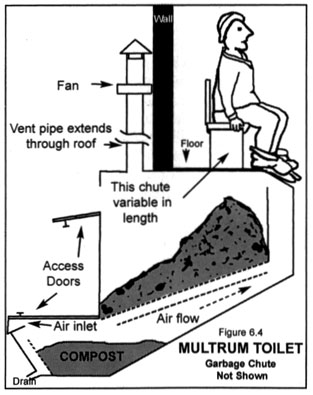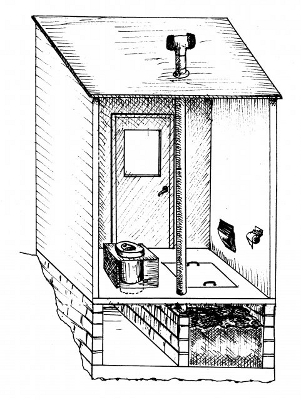
Cool composting of humanure
 Before The
Humanure Handbook
hit the stage, most of the systems in practice were cool composting
toilets. In contrast to Jenkins' thermophilic composting system
(which I'll discuss in Thursday's post), these cool composting systems
relied on time to kill off any pathogens in the humanure.
Before The
Humanure Handbook
hit the stage, most of the systems in practice were cool composting
toilets. In contrast to Jenkins' thermophilic composting system
(which I'll discuss in Thursday's post), these cool composting systems
relied on time to kill off any pathogens in the humanure.
In general, leaving a
pile of humanure to compost for two years is a sufficient safety margin
even if the pile doesn't heat up at all, although roundworm eggs can
survive for up to ten years under these conditions. If you apply
composted humanure under the mulch around ornamentals or fruit trees,
though, this issue may not matter.
The Clivus Multrum is
probably the best known of the cool composting systems, and most of the
other designs work similarly. Jenkins recommends designing a cool
composting toilet with at least two chambers so you can close off one
after filling and let the humanure age for a couple of years before
removing the compost. When starting a new chamber, fill it about  halfway with an
absorbent, high carbon material, then keep more of the
sawdust on hand to drop down the hole after each use. A
chimney-pipe-type ventilation system will pull any smells up above
nose-level, and leachate can be collected in a five gallon bucket of
sawdust that is tossed back down the hole at intervals.
halfway with an
absorbent, high carbon material, then keep more of the
sawdust on hand to drop down the hole after each use. A
chimney-pipe-type ventilation system will pull any smells up above
nose-level, and leachate can be collected in a five gallon bucket of
sawdust that is tossed back down the hole at intervals.
Despite the problem with
using humanure compost from this type of toilet on food crops, it does
have a major advantage --- simplicity. Unlike Jenkins' system,
there's little regular maintenance required beyond finding sawdust, and
the compost is high quality after the extended aging period.
I'd be curious to hear
from anyone who's using a cool composting system like this. What
design did you use (or what brand did you buy)? How has it worked
out for you? Do you have additional pros and cons to add to this
description?
| This post is part of our The Humanure Handbook lunchtime series.
Read all of the entries: |
Want more in-depth information? Browse through our books.
Or explore more posts by date or by subject.
About us: Anna Hess and Mark Hamilton spent over a decade living self-sufficiently in the mountains of Virginia before moving north to start over from scratch in the foothills of Ohio. They've experimented with permaculture, no-till gardening, trailersteading, home-based microbusinesses and much more, writing about their adventures in both blogs and books.
Want to be notified when new comments are posted on this page? Click on the RSS button after you add a comment to subscribe to the comment feed, or simply check the box beside "email replies to me" while writing your comment.

You would have to ask my mother for specific technical details but this is effectively the system I grew up with. There were two chambers. She drained leacheate off and diluted and watered the woods with it periodically. I remember her digging out the solids from time to time, it was very periodic. Those had a burial spot that, if I remember correctly brambles of some sort were planted over.
There was a fan on a vent pipe that went up through the roof. People were weirded out by it but the only disturbing thing was the spider that periodically crawled up from the dark. There were no flies, nor any smell. Worked well for 10+ years.
C, I'd be curious to hear more about your mother's sytem. When I was a kid we had a supposedly composting toilet, but we never included sources of carbon, so the humanure didn't really rot properly. Did your parents throw any sawdust or other materials down the hole?
Irma --- Don't feel guilty! That's not the point at all. I want people to be empowered to make any changes that feel good to them, not feel guilty about the changes they don't make.
I want people to be empowered to make any changes that feel good to them, not feel guilty about the changes they don't make.
Sorry for the late reply. It was built in, toilet fixture didn't move, indoor, two bins under the floor, built out of ferrocement and concrete block. I do not know the mechanism to switch between the bins but I remember her emptying them very rarely, roughly 3 people using full-time, year-round.
I know that sometimes sawdust or leaves made it down the hole but there wasn't a scoop after you poop system or anything like that. What came out the back side was liquid, she drained that fairly often, like twice a year. The rest was effectively peat moss in look and smell. Mind you this is childhood recollection.
My father was the carpenter but my mom the stonemason. She made most of the design of the house and consulted with the Nerings by mail to finalize details and get concepts right. If you really want details I can ask her to do a drawing next time I get some time with her...